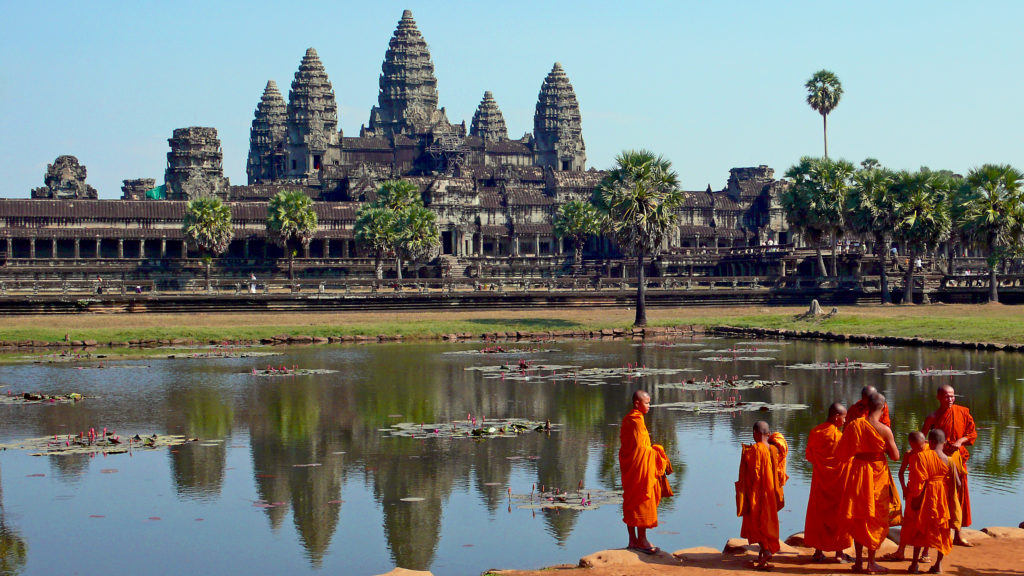The population of Cambodia is approximately 95 percent Theravada Buddhist, as high a percentage as anywhere in Asia. Cambodian Buddhism is associated with the historic Ankgor Wat temple, a jewel of Khmer civilization. The Khmer, who have lived in what is now Cambodia since the 9th century, are the dominant ethnic group in Cambodia.
Buddhism reached Cambodia before the Khmer, however. It is recorded that the Emperor Ashoka sent missionaries to that part of Asia in the 3rd century BCE (see “The Third Buddhist Council: Pataliputra II“). However, the mission seems to have failed.
There is evidence that Buddhism was being practiced in Cambodia by about the 3rd century CE. This was a Sanskrit lineage, possibly Sarvastivada or early Mahayana. Hinduism was also prevalent in the region, resulting in a kind of Buddhist-Hindu hybrid practice that included veneration of Shiva. Chinese travelers recorded that by the 5th century Buddhism was thriving in the region.
The first Khmer king, Jayavarman II (802-869), appears to have associated himself with Shiva, but he also was supportive of Mahayana Buddhism. By then the form of Mahayana being practiced also included elements of tantra yoga along with elements of Hinduism. This religious fusion was practiced by the Khmer through the reign of Jayavarman VII (1181–1215), a great patron of religion.
It was about this time that Theravada Buddhism was making gains among the Khmer, probably brought there by Sinhalese monks from Ceylon (Sri Lanka). One of Jayavarman VII’s sons became a monk and studied in Ceylon, and after he returned the Khmer began to convert to Theravada Buddhism.
Within a few decades, Mahayana had faded away was entirely replaced by Theravada.

Buddhist monks in front of the reflection pool at Angkor Wat, Cambodia. Photo by Ekabhishek, courtesy Wikipedia Commons, Creative Commons License.
Angkor Wat
This famous temple complex is nearly 200 miles northwest of Phnom Penh, but when construction began it was at the heart of the Khmer civilization. Construction is credited to the Khmer King Suryavarman II, who reigned from 1131 to 1150. The complex covers 200 acres and is surrounded by a moat.
The temple originally was dedicated to the Hindu god Vishnu.
Much of the art in the temple, such as the bas-relief carving, depicts scenes from Hindu mythology. It was crafted at the height of Khmer culture and the quality of the art is superb.
By the time Jayavarman VII reigned in the late 12th century, the temple already was being rededicated to Buddhism. But in the 15th century the Khmer civilization collapsed, possibly in part because of food and water scarcity. Although some monks continued to live there, the surrounding population moved elsewhere. Slowly, the temple complex was reclaimed by the jungle.
The complex was unknown to the outside world until French explorers discovered it in the mid-19th century.
The French were so astonished at the beauty and sophistication of the ruined temple that they refused to believe it had been built by the Khmer. It is now a UNESCO World Heritage site, and work to restore the temple is ongoing.
Cambodia After the Khmer Empire
After the Khmer Empire collapsed the population shifted to what is now Phnom Pehn. Buddhism continued to flourish and even proved to be resistant to the efforts of Christian missionaries, who began arriving in the 16th century.
Cambodian society and civilization were much disrupted by European colonialism, however, In the 19th century Cambodia became part of French Indochina, and monks occasionally stirred up resistance to the French.
However, the darkest phase of Cambodian Buddhist history took place under the rule of the Khmer Rouge, which took control of Cambodia in 1975. The Khmer Rouge were determined to destroy Buddhism. In a very few years Cambodia’s monks had been either forcibly de-frocked or executed, and nearly every Buddhist temple and library had been destroyed.
The Khmer Rouge were ousted in 1979 when Vietnamese troops invaded and took control of Phnom Pehn. Buddhism continued to be suppressed during the Vietnamese occupation, however, which continued to 1991. When Cambodia returned to self-government, Buddhism was declared to be the state religion.
[This is an article I wrote for the Buddhism section of About.com. However, since About.com has removed it from their servers, all rights revert to me.]